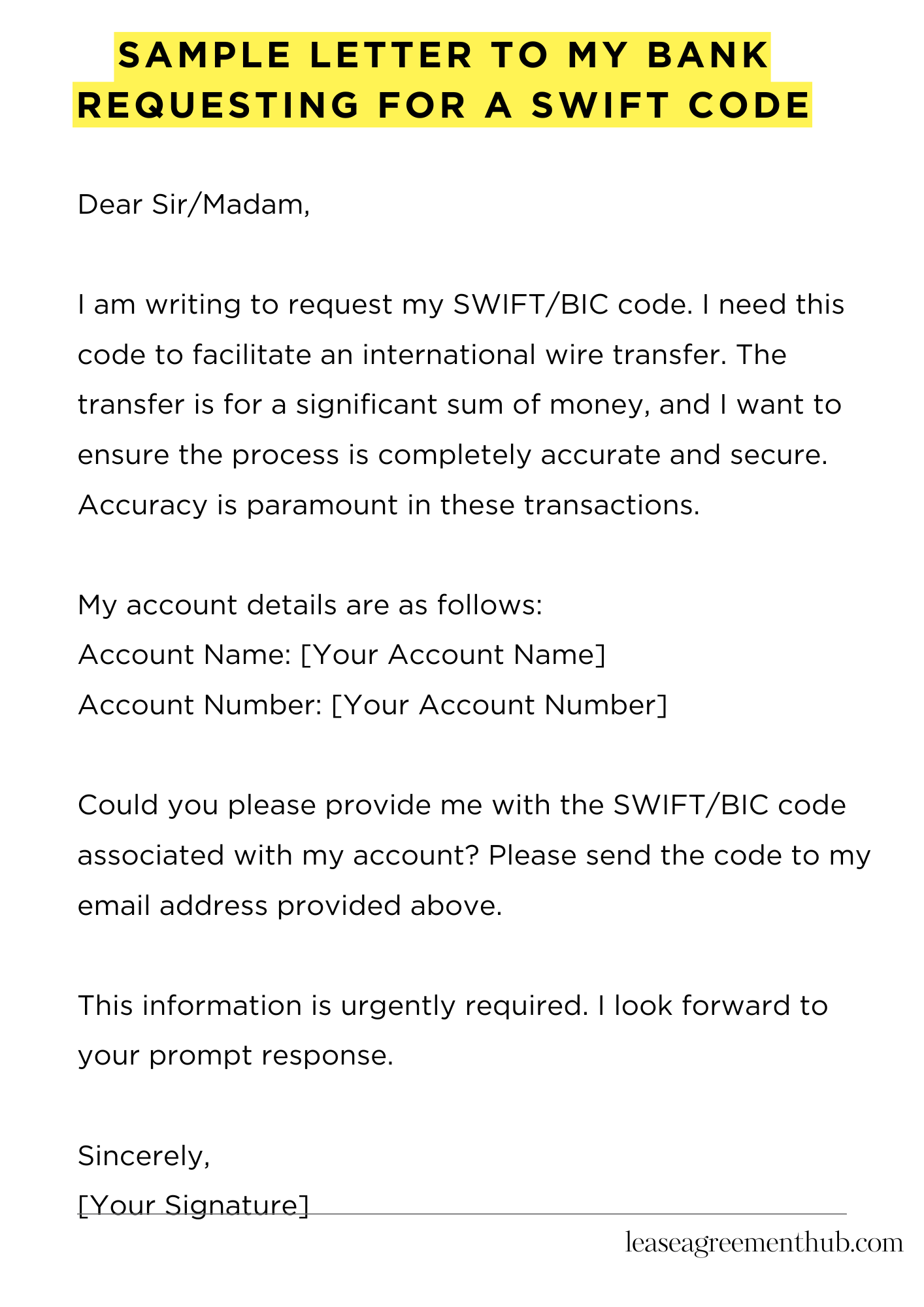Need your bank’s SWIFT code? This is a crucial code for international transfers. A simple letter can get you this information quickly.
This article provides sample letters. Use these templates as guides. They make writing your own letter easy.
We offer various examples. You’ll find the perfect letter for your situation. Save time and effort.
Sample Letter to My Bank Requesting for a SWIFT Code
[Your Name]
[Your Address]
[Your Phone Number]
[Your Email Address]
[Date]
[Bank Name]
[Bank Address]
Dear Sir/Madam,
I am writing to request my SWIFT/BIC code. I need this code to facilitate an international wire transfer. The transfer is for a significant sum of money, and I want to ensure the process is completely accurate and secure. Accuracy is paramount in these transactions.
My account details are as follows:
Account Name: [Your Account Name]
Account Number: [Your Account Number]
Could you please provide me with the SWIFT/BIC code associated with my account? Please send the code to my email address provided above.
This information is urgently required. I look forward to your prompt response. Thank you for your time and assistance. Please contact me if you require any further information.
Sincerely,
[Your Signature]
How to Write a Sample Letter to My Bank Requesting a SWIFT Code
Understanding the Importance of SWIFT Codes
In the labyrinthine world of international finance, the SWIFT (Society for Worldwide Interbank Financial Telecommunication) code acts as a crucial identifier. It’s essentially the postal code for your bank, uniquely pinpointing its location within the global financial system. Without it, international transactions become practically impossible. Knowing this, obtaining your SWIFT code is paramount for seamless cross-border money transfers.
Why Write a Letter? Exploring Your Options
While many banks provide online access to SWIFT codes via their web portals or mobile applications, some institutions may require a formal request. A well-crafted missive provides a documented record of your inquiry, ensuring a more efficient and less ambiguous process. This formal approach offers a degree of probative value, especially if issues arise later. Consider this option if online methods prove fruitless or if you prefer a tangible record of your correspondence.
Crafting Your Salutation: A Formal Approach
Begin with a formal salutation. Avoid informality. Address your letter to the relevant department, such as “The Accounts Department,” or, if you know a specific contact person, use their title and name. Precision in addressing your letter directly to the competent authority streamlines the process and shows your respect for professional decorum. Starting with “To Whom It May Concern” is acceptable if a specific contact is unavailable.
The Body: Clarity and Conciseness are Key
State your purpose succinctly. Clearly state that you require your bank’s SWIFT code. Provide essential identifying information, including your full name, account number, and type of account (checking, savings, etc.). Ambiguity is the enemy of efficiency here. Keep the language precise and devoid of unnecessary embellishment. Your request should be easily understood at a glance.
Closing the Letter: Professional Closure
End your letter with a professional closing such as “Sincerely” or “Respectfully.” Type your full name and contact information below your signature. This provides the bank with a means to respond promptly to your query. Using a legible signature is also important; a messy or unclear signature may delay your request.
Revising and Proofreading: A Necessary Step
Before sending, carefully proofread your letter. Errors in grammar or spelling can diminish the credibility of the entire communication. A well-written letter demonstrates professionalism and attentiveness to detail. Consider asking a trusted friend or colleague to review your letter before your final submission.
Submitting Your Letter: Recommended Methods
You can submit your letter via mail, email (if allowed by your bank), or in person. Check your bank’s preferred method of correspondence. While email is expedient, postal mail provides irrefutable proof of submission. Choose the option that best suits your needs and your bank’s official policy. Remember to retain a copy of the letter for your records.
FAQs about sample letter to my bank requesting for a SWIFT code
Obtaining your SWIFT code is a straightforward process, but having a well-written request can make it even smoother. Below are some common questions about writing a letter to your bank for this information.
What information should I include in my letter requesting a SWIFT code?
Your letter should clearly state your request for your SWIFT BIC code. Include your full name, account number, and contact information (phone number and email address). Specifying the branch, if applicable, can also help expedite the process. It’s also helpful to briefly state the reason for needing the code (e.g., international transfer).
Do I need to use a specific format for my letter?
While there’s no mandatory format, a formal and polite tone is always best. A simple, well-structured letter clearly outlining your request is sufficient. Using a professional letterhead if available can add to the letter’s credibility.
How should I send my letter to the bank?
You can send your letter via mail, email, or fax, depending on your bank’s preferred method of communication. Check your bank’s website or contact them to confirm their preferred contact method. If sending it electronically, ensure that it is scanned clearly if sending via mail.
What if my bank doesn’t provide a SWIFT code for my account?
If your bank doesn’t provide a SWIFT code, it’s important to inquire further. This could indicate that the account type doesn’t support international transfers or that there might be a misunderstanding. Contact your bank’s customer service to clarify the situation and explore potential solutions.
Is it possible to find my SWIFT code online or through other means besides writing a letter?
Many banks allow you to find your SWIFT/BIC code online through online banking portals. However, if you cannot locate the information online or prefer a more formal approach, writing a letter provides a documented record of your request. You can also try contacting your bank’s customer service directly.
Related: